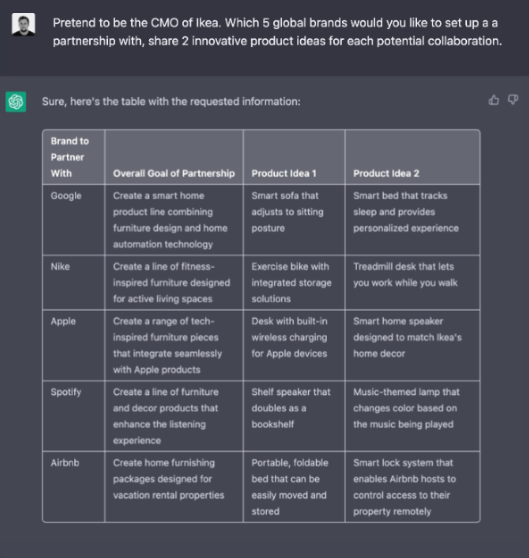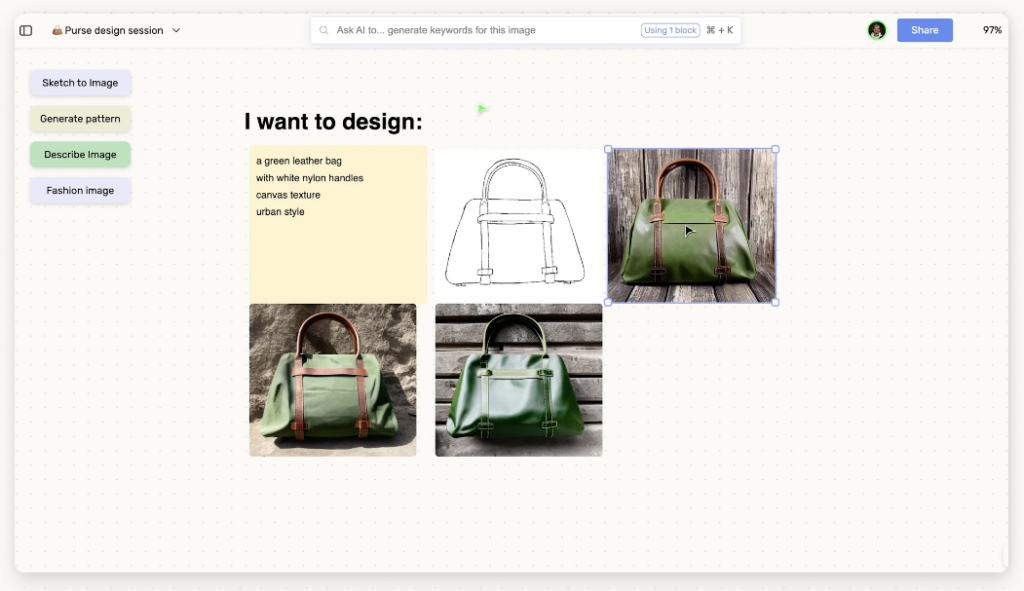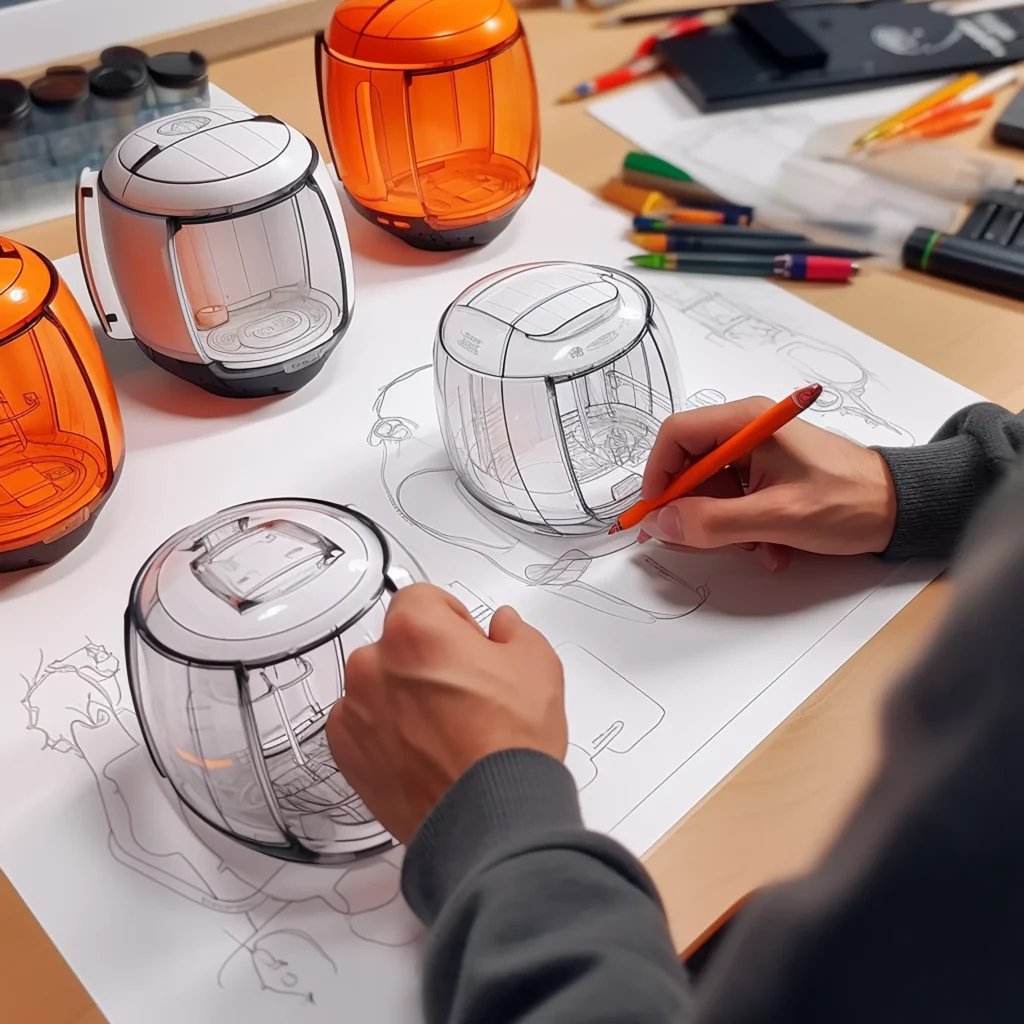The role of generative AI in your innovation process
AI will not replace innovators. But innovators who use AI will replace those who don’t.
Phil De Ridder, CEO | Board of Innovation
The world’s most ambitious companies are already leveraging generative AI to create new products and services.
AB InBev has created the world’s first beer and full marketing campaign made with AI, naming it Beck’s Autonomous. And IKEA’s research and design lab shares a portfolio of AI-generated furniture inspired by designs from 1970s and 1980s IKEA catalogs.
Generative AI will change the entire innovation process from strategy to go-to-market. In this blog post we uncover some of the roles generative AI play in the innovation process.
The role of generative AI in innovation strategy
Within the first phase of the innovation process, strategy, generative AI will help you generate strategic insights and drive decision making, faster.
AI models trained on all strategic frameworks, with access to decades of data, case studies, etc. will soon outperform traditional strategy consultants on set tasks.
Trained on proprietary company data it will help you generate strategic insights, explore different future scenarios, and inform decision making.
Some argue that you will always require human strategic decision making to guardrail against unethical behavior but looking at history the evidence that human decision making leads to ethical behavior is unconvincing.
Use cases and sample tools
Generative AI can help you radically change the way you find, explore and decide on which new avenues to pursue as a business.
Board of Innovation built a tool that allows you to get strategic advice from Michael Porter, Peter Drucker and Clayton Christensen. We also developed a Future Scenario Writer to generate a future scenario, based on your main product or service, your industry and a future year.
Rationale is a tool helping business owners when making important decisions, by considering all relevant factors and your background.
How businesses are doing it
Healthcare: Valo uses AI to transform the discovery and development of life-changing medicines.
Consumer goods: ChatGPT took the reins as CEO of a Portugese startup, Alsthetic Apparel, selling t-shirts with AI-generated designs. The business was profitable within a week.
Industrials: Stuttgart-based startup Sereact recently raised a $5m seed round to scale its generative AI technology that lets warehouse robots autonomously pick and pack.
The role of generative AI in insights
Consumer insight is dead. Long live consumer insight.
Generative AI enables us to transform our existing (proprietary) research data into new insights that can help us understand our customers better – and make that ability accessible to everyone in the organization. This will help us save resources, and avoid redundant – and often repetitive – primary research.
We can also train AI agents to represent specific personas or customer segments – to quickly simulate conversations, test value propositions, and gain insights from their feedback.
Nevertheless, we still need to be curious and use generative research methods that discover new trends and insights.
Use cases and sample tools
With generative AI, you can use synthetic personas and user journeys to quickly gain behavioral insights. You can scrape and analyze vast amounts of data and use social listening to gain deeper insights.
Synthetic Users lets you gain starting intelligence on your consumers before you go test your concept with real people.
Kraftful uses AI to summarize user feedback and works as a social listening tool, as it analyzes how often users mention topics and lets you find original feedback in context.
Akkio lets you engage with your data, generating insights and actionable predictions.
With InfraNodus, you can for example import product reviews from Amazon and run an AI-driven contextual analysis to gain insights into what drives consumer behavior.
How businesses are doing it
Healthcare: Novartis and Microsoft have created a strategic alliance to utilize AI to unlock valuable new insights from vast amounts of data.
Consumer goods: PepsiCo used an AI tool to analyze millions of posts on social media resulting in insights that prompted the development of Off The Eaten Path seaweed snacks.
The role of generative AI in ideation

Generative AI lets us generate infinite ideas and curate down these ideas. The key to ideation is divergent thinking. Creative AI tools basically bring divergent thinking on steroids.
They enable us to go beyond the first idea and explore a variety of solutions for any problem. With Creative AI tools, we can leverage the power of divergent thinking without spending hours on creative exercises.
With well-crafted, and properly thought-out prompts, we can gain ideas from different perspectives and domains. Then, we can curate the best ones from a long list of options.
Use cases and sample tools
You can use Generative AI to push the envelope and generate more ideas faster – use generative AI for idea generation, concept prioritization, value proposition design, and business model innovation.
Fermat helps you ideate and refine products by converting a rough, drawn sketch into several product visualizations with different specifications and variations.

Seenapse allows you to generate hundreds of divergent, creative possibilities in minutes and our own Brainstorm Buddy helps you spark your next big idea.
How businesses are doing it
Healthcare: Roche uses AI for space exploration, and using it to ask bigger questions and address previously intractable challenges in human biology and disease.
Consumer goods: Zhong Xue Gao launched a new AI designed ice cream using Creative AI for flavor recommendations, packaging and branding as well as the promotional video.
Industrials: In the scientific context of molecule discovery, AI models like Deepmind’s AlphaFold have already proven to surpass human ability to ideate and discover new molecules (200M vs 150K structures)
The role of generative AI in design
Design is being reshaped by generative AI design tools. These tools enable anyone to generate and visualize ideas in various design domains.
As these tools become more accessible and intuitive, the role of designers will shift. Designers will concentrate more on editing than creating, on industrial design than concept design, and on prompt engineering than sketching. Generative AI design tools will democratize design and foster more innovation.
Use cases and sample tools
Use generative AI for prototyping your concepts, generating/editing videos, digital design, and coding.
The tools range from Midjourney, which can produce product designs from natural language, to Dall-E2, which can create digital art from text and image inputs, to Stable Diffusion, which can synthesize realistic images from sketches.
How businesses are doing it
Healthcare: Medtronic are adding AI to their research and design capabilities to push the boundaries of innovation. The company has launched the only FDA cleared “smart” insulin pen, integrated with AI.
Consumer goods: we asked AI to generate 20 sustainable packaging solutions for consumer goods – check them out.
Industrials: Nvidia Omniverse lets you run AI powered scenarios for industrial factory design.
Unlock the power of AI in a unique sprint format. Leverage the latest AI tools to generate new ideas, get real-time feedback, and curate new concepts to move forward with.
The role of generative AI in go-to-market
Your go-to-market will need to break through choice overload.
Creative AI can run many tasks that are essential for marketing and running a business. It can write persuasive messages, build websites, create models for ad campaigns, and run customer service. This may seem like a distant future, but it is closer than we might think.
This also means that over time the market will be flooded with new AI-generated products and services, making it harder to stand out and reach your customers. Moreover, customers will have their own AI systems that filter and curate content as well as products, based on their preferences and needs.
Marketing and branding will likely become hyper personalized, tailored to each individual customer and context.
Use cases and sample tools
Run the go-to-market plan with AI, develop a messaging strategy fitting with your audience, design campaigns, and copywrite faster.
DigitalFirst lets you create and execute marketing plans in seconds with AI.
AdCreative generates conversion focused ad creatives and social media posts.
How businesses are doing it
Healthcare: Chinese undertakers are starting to explore new revenue streams and services to families so they can communicate with their loved ones.
Consumer goods: Coca-Cola built a platform to allow digital creatives to generate original artwork with iconic creative assets from the Coca-Cola archives leveraging ChatGPT and Dall-E2.
This is the worst AI will ever be
We’re just at the cusp of what AI can do and AI will evolve further beyond text, to voice and thoughts.
At the moment, AI has its limitations and how we as humans interact with AI, e.g. through how we prompt tools like ChatGPT or Midjourney, is a critical element in the success and further adoption of AI.
An example of the importance of Human + Machine is synthetic personas; the effectiveness of synthetic personas heavily relies on the quality and diversity of the training data. If the data is skewed or incomplete, the personas may exhibit biases or inaccuracies. Achieving a human-like response requires us to incorporate qualitative inputs into the training of the AI tool. While it’s possible to create synthetic personas solely with generative AI, the persona will lack the richness of interaction and authenticity, that a trained persona would have.
Additionally, while we can use synthetic personas to quickly get feedback on a concept and then do minor tweaks, that concept still needs to be validated in the market with experimentation and real-world data.
Another example of the importance of humans in GenAI is in the ideation process. While generative AI lets us generate hundreds of ideas, in no time, AI may struggle to comprehend the subtle nuances, emotions, and cultural contexts that are integral to ideation. As a result, its suggestions might miss the mark in terms of appropriateness or relevance. This is where we as humans have to thoughtfully craft the right prompt and monitor the ideation outputs closely, keeping an eye out for biases, and subtle contextual nuances.
Conclusion
Generative AI is already transforming innovation processes across industries. In our recent report on the Age of Creative AI, we give four predictions to the development of AI, and help you navigate your strategic response to generative AI with frameworks and tools.
Join us at our virtual Autonomous Innovation Summit to discover how AI is changing the way we innovate, operate and design – and how businesses can transform to thrive in this autonomous world.


